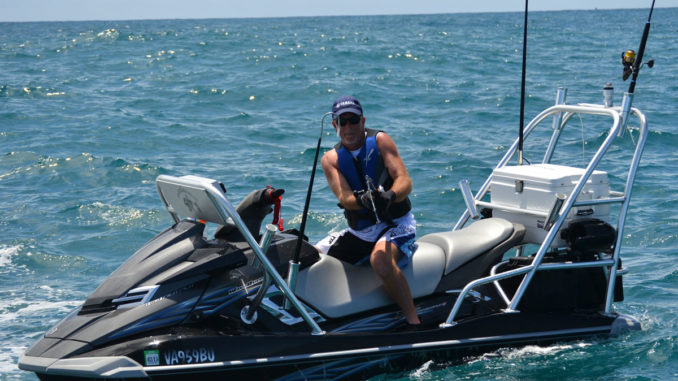
Jet skis offer a minimalist approach to fishing, especially when you head out Beaufort Inlet for bottom-fishing around nearshore reefs.
Something seemed out of place. While it’s not uncommon to see a personal watercraft, aka jet ski, putting in at the Newport River boat ramp near Radio Island, this one was different.
A large cooler with rod holders was mounted on the stern. A Humminbird fish finder was mounted on the console just below the instrument gauges. This Yamaha Waverunner was about to do something other than jump wakes from the many many boats in the waters around Beaufort Inlet.
North Carolina’s coastal waters have a number of wrecks and artificial reefs that provide great fishing opportunities, and many are within a few miles of the shoreline. The area near Fort Macon, just outside Beaufort Inlet, is home to several of these reefs — AR 315, AR 320 and AR 330 — are within an easy ride for a properly equipped jet ski, offering a different and unique fishing adventure.
Jet skis as fishing vessels have a large following in other countries, New Zealand to name one, and they have a small, dedicated base in North America. Individuals such as Brian Lockwood of Poquoson, Va., continue to build interest in the sport through blogs, lectures, videos and guide services.
The jet ski provides a more individualistic approach, much like a kayaker’s preference, with easier transport and cost savings on both equipment and fuel. All you need is a cooler, a place to keep your rods and tackle during the ride to the reef, and your regular safety equipment. Many top-of-the-line setups include fish finders, GPS units and marine radios along with aluminum bar rack additions to hold coolers and rods for both transit and trolling.
Other setups include PVC racks serving the same purpose as aluminum versions but on an easily removable and budget-minded platform. A cooler with a common ratchet strap will handle the duty for first-timers wishing to try their hand without too much of a change to their personal watercraft.
To fish a variety of areas and different depths, a GPS unit comes in handy unless you’re following another boat to the same location. If attempting the trip alone, it is always safer to have a backup. Many marine radios have built-in GPS unites, as well as fish finders. While cellular service may be interrupted, cell phones may still pick up GPS coordinates and can be used with an off-line mapping program or application.
Lockwood set up his fishing jet ski up with an extra battery to provide power to his radio and fish finder, and it also offers him a backup starter battery just in case the primary battery fails.
A minimalist approach on tackle works best when using a jet ski; nearshore reef fishing fits well in that equation. A number of bottomfish are abundant in the summer, including grunts, pigfish, triggerfish and black sea bass. A 2-hook bottom rig, baited with shrimp and carrying a 3- or 4-ounce weight will usually keep you busy bringing fish to the cooler. A Carolina rig with similar terminal hooks and an egg sinker is an alternative, as is a single-hook bottom rig.
On a 2-hook bottom rig, try using shrimp on one hook and squid, crab or cut bait on the other when the bite is slow or to try for a larger variety of fish scouring the reef for an easy meal.
It is possible to hit an occasional school of cobia, and a rod rigged with a bucktail is often enough to entice a hookup. The bucktail can also be jigged off the botttom when the fish finder alerts you of larger fish at the deeper depths as well, plus summer flounder.
As far as safety goes, concerns with using a jet ski several miles off the beach should be the same as when using a standard fishing vessel. While it is recommended to add a bilge pump system, a jet ski is designed to get wet all over. Even crashing waves roll over the personal watercraft and flow off, unlike a boat that can have water fill the deck.
Jet skis can also be used to fish reefs farther offshore, with fuel supply being the only limiting factor. Lockwood has been as far as 60 miles out of Hatteras; however, a chase boat was used for precaution and to carry extra extra fuel.
DESTINATION INFORMATION
HOW TO GET THERE/WHEN TO GO — The Morehead City/Beaufort/Atlantic Beach area is accessed from most parts of North Carolina by US 70, with US 17 a good connecting route through New Bern. Popular public boat ramps include N.C. Wildlife Resources Commission ramps on US 70 at the N.C. Division of Marine Fisheries headquarters and in Beaufort on Taylors Creek, and a ramp on the Newport River in Beaufort maintained by Carteret County. Reaching nearshore reefs such as AR 315, AR 320 and AR 330 on a jet ski to catch bottomfish is a great summer activity due to the number of species available, but fishing can be great into September and early October.
TACKLE/TECHNIQUES — Medium to medium-heavy spinning tackle with 2-hook bottom rigs is all you need to sample most of the bottomfish species found around nearshore reefs: grunts, triggerfish, black sea bass and flounder. Carry a heavier outfit with a bucktail jig and soft-plastic trailer for occasional shots at cobia or amberjack.
FISHING INFO/GUIDES — Capt. Joe’s Bait & Tackle, Atlantic Beach, 252-240-2744; Chasin’ Tails Outdoors, Atlantic Beach, 252-240-3474. See also Guides and Charters in Classifieds.
ACCOMMODATIONS — Crystal Coast Tourism Authority Morehead City, 252-726-8148, www.crystalcoastnc.org; Carteret County Chamber of Commerce, Morehead City, 252-726-6350, www.nccoastchamber.com.
MAPS — Capt. Segull’s Nautical Charts, 888-473-4855, www.captainsegullcharts.com; Sealake Fishing; Guides, 800-411-0185, www.thegoodspots.com; Maps Unique, 910-458-9923, www.mapsunique.com; GMCO Chartbook of North Carolina, www.gmcomaps.com.







Be the first to comment